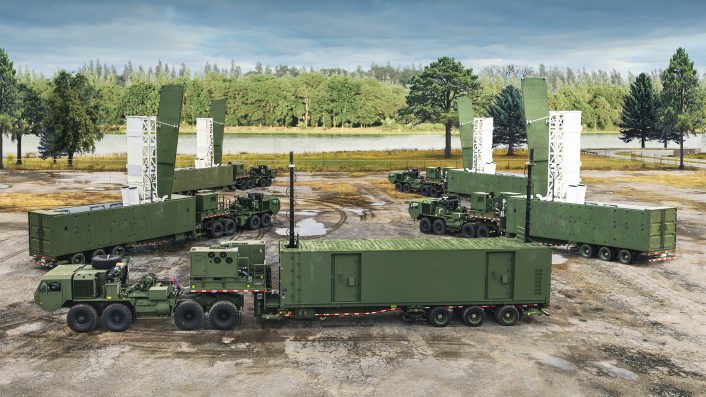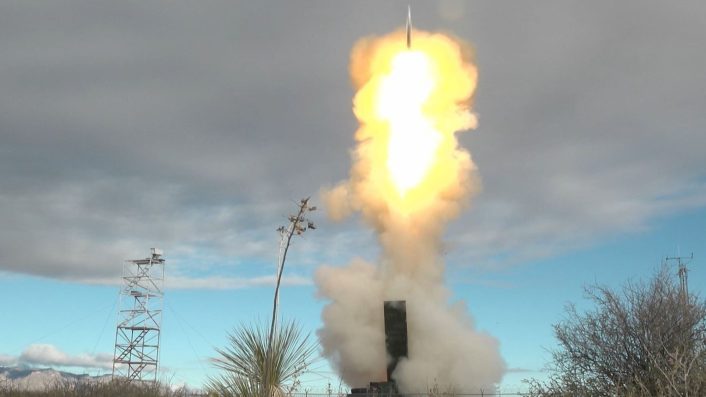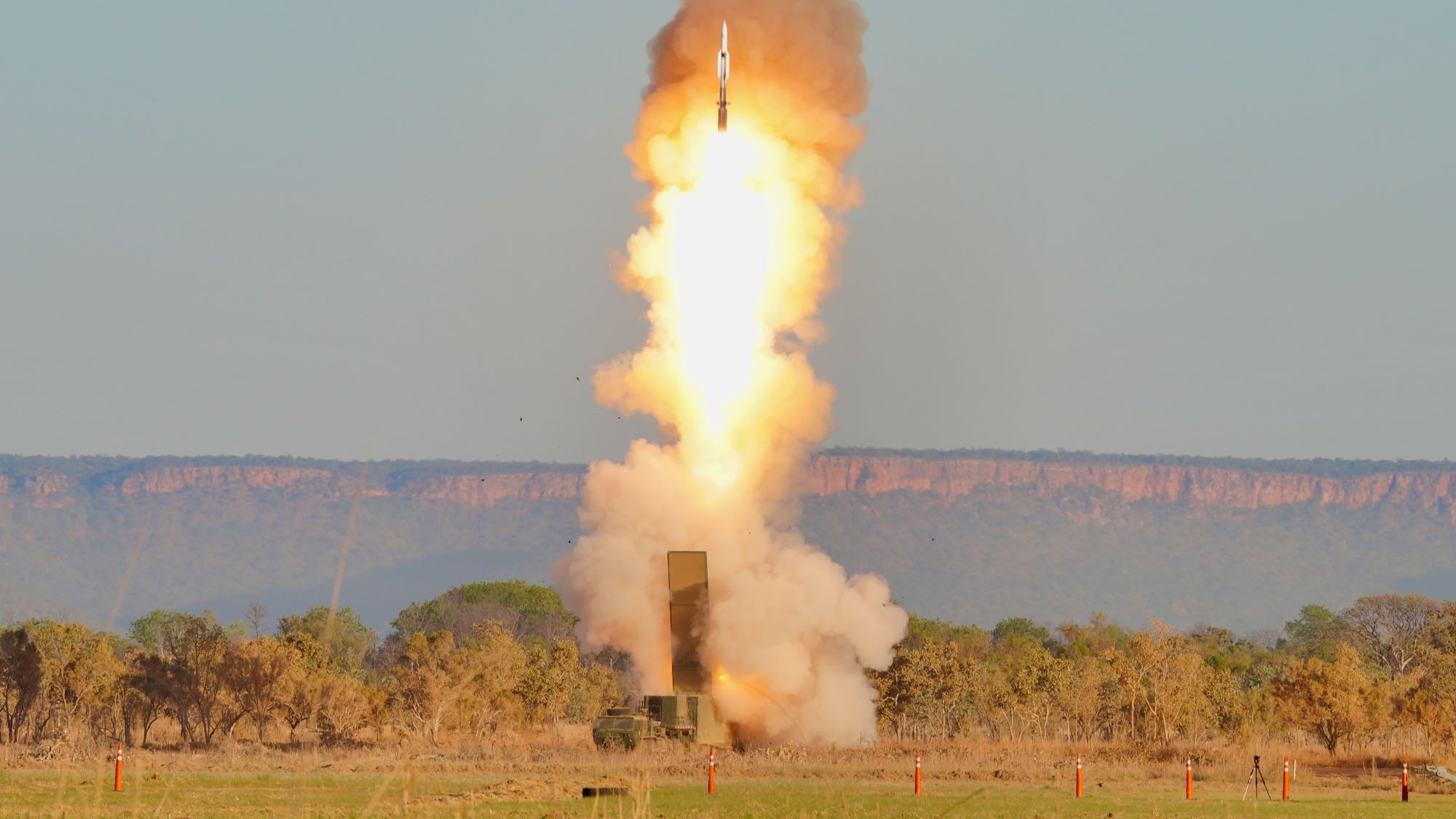The U.S. Army’s Third Domain Multi-Domain Working Group held on the opening date of the campaign Talisman Saber in 2025
US Army Implementation The first live fire Standard Missile 6 (SM-6) is part of the Medium Distance Function (MRC) Typhon system, where exercise amulets are practiced in Australia, outside of the Continental United States (CONUS). The missile was launched from Australia’s Northern Territory on July 16, 2025, and the missile successfully hit and sank an unspecified maritime target, the press release said.
The SM-6’s surface-to-air missile (SAM) is used to shoot down fast-flying fighter jets, helicopters, cruise missiles and ballistic missiles at the terminal stage. The weapon has evolved to also include a surface impact character and is launched by the MK 41 Vertical Launch Silo (VLS), which carries missiles from the U.S. Navy Arleigh Burke-class destroyer, or the Road-Mobile Typhon Tryphon Transporter Erator Erector Inertrater Launcher (TEL), which itself was derived from the MK 41.
Images posted on the DVD network show the various stages of the missile, with its MK 41 cell without visual or information about the type of sea target hit. The fire on site demonstrated “rapid improvement of capabilities and capabilities […] to support regional security and stability of advanced maritime strike capabilities. ”
The U.S. Army said the test, bilateral amulet practice and participation of the 10th Australian Brigade highlighted the strength of the Australian Alliance in America. In fact, successful real-time fire tests validate the joint joint positioning and command and control interoperability between 3MDTF and the joint joint forces involved in the exercise.
🇺🇸🇦🇺 Major wins in alliance and regional stability to support #freeandopenopacific.#Talismansabre25 #TS25 #alliesandpartners #Multidoman #lethality #CAMPAINGING #OperationPathways
📸perla alfaro Sergeant, third MDTF pic.twitter.com/0M1SXMHZ3G
— US Army Pacific (@usarpac) July 16, 2025
The importance of this test is that Talisman Saber has a larger multinational component, while the involvement of the Japanese, Singapore, France and South Korea carried out large-scale ground drills.
The test was conducted on the second day of the official Germany Require Clearing to buy Typhon. Interestingly, the request was announced last year that the U.S. military will be strengthened through missile systems such as Typhon. Starting in 2026.
test
This is the first time when the land-based MRC fired west of the International Date (IDL), the U.S. Army said the test also showed “the ability to deploy the U.S. Army’s long-range precision fire (LRPF) forward.” The Third MDTF and Joint Forces validated “the ability to execute command and control (C2) of land-based sea strikes with the emerging multi-domain construct of the Australian Army.”
Third MDTF commander Colonel Wade Germann said the MRC deployed and successfully performed the SM-6 real-time fire to target maritime targets, which is the department’s ability to deploy, integrate, command and control advanced land sea strike capabilities.” The release highlights how the test coordinates command and control (C2) interoperability between the third MDTF and its counterpart (10th Australian Brigade) through land effects.


Neither the United States nor Australia mentioned which assets were involved in the test besides Typhon. Australian MQ-4C Triton Or P-8 Poseidon may have been used to identify maritime targets during participation.
“Site fires provide valuable insights and lessons learned that will inform future development and employment of land maritime and strategic strike capabilities.” A system can be carried in a C-17 Globemaster III cargo aircraft, e.g. May 2024When MRC Typhon was moved to Bornholm on the Denmark island of the Baltic Sea to perform the movement.
Exercise amulet
According to the Australian Ministry of Defense, the amulet weapon soldier, which began on July 14, 2025, involved 19 countries and more than 30,000 service members. To date, this is also known as the largest bilateral military training activity between the United States and Australia.
On May 5, the U.S. Navy MK31 medium-sized tactical vehicle replaced the U.S. Air Force C-17 Globemaster III container launch system. pic.twitter.com/wonmzu69q1
– Ryan Chan (@ryryankakiuchan) May 6, 2024
“This represents the most complex iteration of the bodyguard ever,” the U.S. Army said during its release. “The geographical scope of training, the current number of service staff, and the proven advanced technology and capabilities reflect the professionalism and fatality of participating countries. In the coming weeks, tests will be conducted, these units will be practiced, and determined to last long regional stability.”
MRC Typhon
MRC Typhon, except SM-6 (Standard Missile-6) has adjusted the ground strike, and the Tomahawk LACM (land attack missile) can also be used. Both reportedly have a range of more than 1,500 kilometers.
The Typhon system is part of the U.S. Army Multi-domain working group (MDTF). The other components are Remote ultrasonic weapons (LRHW) and Lockheed Martin Precision strike missiles (PRSM), with a range of 2,776 km and 400-500 km, respectively.
According to information published by the Army, the complete Typhon battery consists of four transmitters, a trailer-based mobile command post, and other auxiliary vehicles and devices.


Meanwhile, the PRSM Increment 1 variant achieved a milestone on July 2, 2025, “the transition to the program to production and deployment phase,” the program executive office missiles and space Announce. Following closely behind is “Double Shooting” Field fire test of PRSM in White Sands Missile Range in New Mexico November 19, 2024part of the “Production Qualification Flight Test”.







